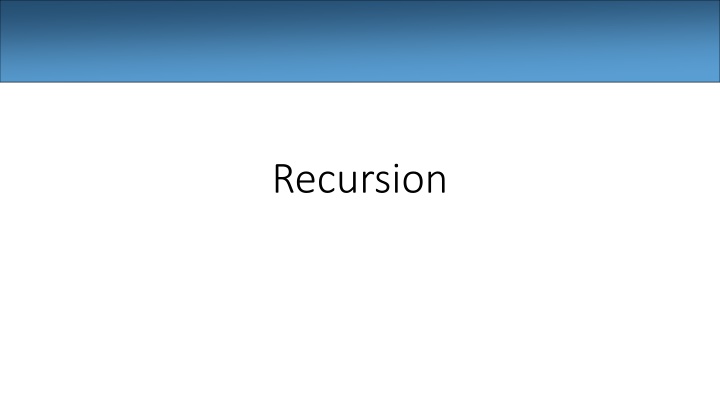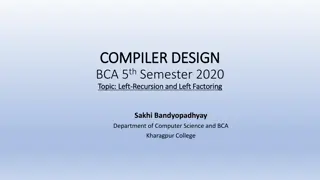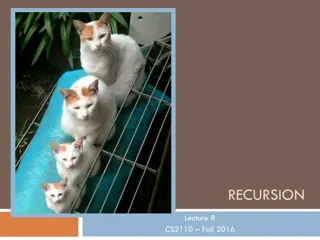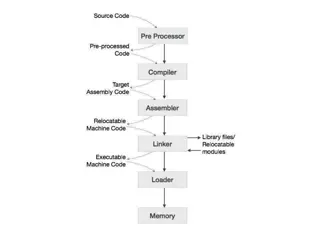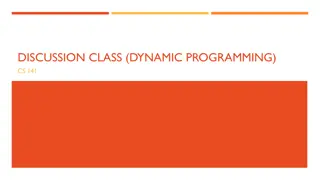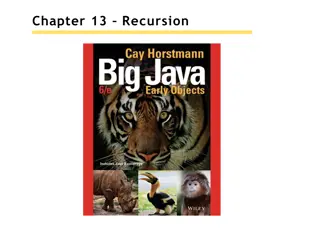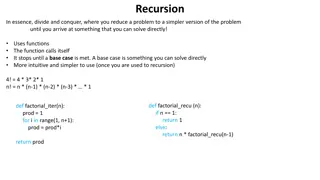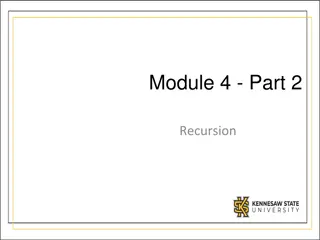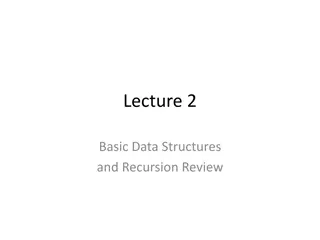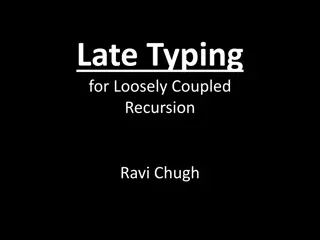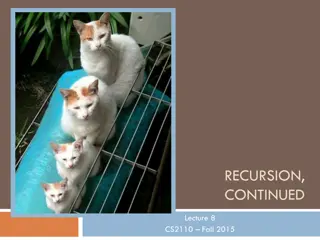Exploring the Power of Recursion in Programming
Understanding recursion is essential for solving complex problems efficiently in programming. Recursion involves breaking down a big problem into smaller instances of the same problem, leading to elegant and concise code. By learning recursion, programmers gain a different perspective on problem-solving and can tackle certain problems more effectively than using traditional iteration methods. This post delves into the concept of recursion, its importance in programming, and provides practical examples to illustrate its usage.
Download Presentation

Please find below an Image/Link to download the presentation.
The content on the website is provided AS IS for your information and personal use only. It may not be sold, licensed, or shared on other websites without obtaining consent from the author.If you encounter any issues during the download, it is possible that the publisher has removed the file from their server.
You are allowed to download the files provided on this website for personal or commercial use, subject to the condition that they are used lawfully. All files are the property of their respective owners.
The content on the website is provided AS IS for your information and personal use only. It may not be sold, licensed, or shared on other websites without obtaining consent from the author.
E N D
Presentation Transcript
Recursion recursion: The definition of an operation in terms of itself. Solving a problem using recursion depends on solving smaller occurrences of the same problem. recursive programming: Writing methods that call themselves to solve problems recursively. An equally powerful substitute for iteration (loops) Particularly well-suited to solving certain types of problems
Why learn recursion? "cultural experience" - A different way of thinking of problems Can solve some kinds of problems better than iteration Leads to elegant, simplistic, short code (when used well) Many programming languages ("functional" languages such as Scheme, ML, and Haskell) use recursion exclusively (no loops)
Exercise How many students total are directly behind you in your "column" of the classroom? You have poor vision, so you can see only the people right next to you. So you can't just look back and count. But you are allowed to ask questions of the person next to you. How can we solve this problem? (recursively )
The idea Recursion is about breaking a big problem into smaller occurrences of that same problem. Each person can solve a small part of the problem. What is a small version of the problem that would be easy to answer? What information from a neighbor might help me?
Recursive algorithm Number of people behind me: If there is someone behind me, ask him/her how many people are behind him/her. When they respond with a value N, then I will answer N + 1. If there is nobody behind me, I will answer 0.
Recursion and cases Every recursive algorithm involves at least 2 cases: base case: A simple occurrence that can be answered directly. recursive case: A more complex occurrence of the problem that cannot be directly answered, but can instead be described in terms of smaller occurrences of the same problem. Some recursive algorithms have more than one base or recursive case, but all have at least one of each. A crucial part of recursive programming is identifying these cases.
Recursion in Java Consider the following method to print a line of * characters: // Prints a line containing the given number of stars. // Precondition: n >= 0 public static void printStars(int n) { for (int i = 0; i < n; i++) { System.out.print("*"); } System.out.println(); // end the line of output } Write a recursive version of this method (that calls itself). Solve the problem without using any loops. Hint: Your solution should print just one star at a time.
A basic case What are the cases to consider? What is a very easy number of stars to print without a loop? public static void printStars(int n) { if (n == 1) { // base case; just print one star System.out.println("*"); } else { ... } }
Handling more cases Handling additional cases, with no loops (in a bad way): public static void printStars(int n) { if (n == 1) { // base case; just print one star System.out.println("*"); } else if (n == 2) { System.out.print("*"); System.out.println("*"); } else if (n == 3) { System.out.print("*"); System.out.print("*"); System.out.println("*"); } else if (n == 4) { System.out.print("*"); System.out.print("*"); System.out.print("*"); System.out.println("*"); } else ... }
Handling more cases 2 Taking advantage of the repeated pattern (somewhat better): public static void printStars(int n) { if (n == 1) { // base case; just print one star System.out.println("*"); } else if (n == 2) { System.out.print("*"); printStars(1); // prints "*" } else if (n == 3) { System.out.print("*"); printStars(2); // prints "**" } else if (n == 4) { System.out.print("*"); printStars(3); // prints "***" } else ... }
Using recursion properly Condensing the recursive cases into a single case: public static void printStars(int n) { if (n == 1) { // base case; just print one star System.out.println("*"); } else { // recursive case; print one more star System.out.print("*"); printStars(n - 1); } }
"Recursion Zen" The real, even simpler, base case is an n of 0, not 1: public static void printStars(int n) { if (n == 0) { // base case; just end the line of output System.out.println(); } else { // recursive case; print one more star System.out.print("*"); printStars(n - 1); } } Recursion Zen: The art of properly identifying the best set of cases for a recursive algorithm and expressing them elegantly.
Recursive tracing Consider the following recursive method: public static int mystery(int n) { if (n < 10) { return n; } else { int a = n / 10; int b = n % 10; return mystery(a + b); } } What is the result of the following call? mystery(648)
A recursive trace mystery(648): int a = 648 / 10; // 64 int b = 648 % 10; // 8 return mystery(a + b); // mystery(72) mystery(72): int a = 72 / 10; // 7 int b = 72 % 10; // 2 return mystery(a + b); // mystery(9) mystery(9): return 9;
Recursive tracing 2 Consider the following recursive method: public static int mystery(int n) { if (n < 10) { return (10 * n) + n; } else { int a = mystery(n / 10); int b = mystery(n % 10); return (100 * a) + b; } } What is the result of the following call? mystery(348)
A recursive trace 2 mystery(348) int a = mystery(34); int a = mystery(3); return (10 * 3) + 3; // 33 int b = mystery(4); return (10 * 4) + 4; // 44 return (100 * 33) + 44; // 3344 int b = mystery(8); return (10 * 8) + 8; // 88 return (100 * 3344) + 88; // 334488 What is this method really doing?
Exercise Write a recursive method pow accepts an integer base and exponent and returns the base raised to that exponent. Example: pow(3, 4) returns 81 Solve the problem recursively and without using loops.
pow solution // Returns base ^ exponent. // Precondition: exponent >= 0 public static int pow(int base, int exponent) { if (exponent == 0) { // base case; any number to 0th power is 1 return 1; } else { // recursive case: x^y = x * x^(y-1) return base * pow(base, exponent - 1); } }
An optimization Notice the following mathematical property: 312 = 531441 = 96 = (32)6 = (92)3 = ((32)2)3 531441 When does this "trick" work? How can we incorporate this optimization into our pow method? What is the benefit of this trick if the method already works?
pow solution 2 // Returns base ^ exponent. // Precondition: exponent >= 0 public static int pow(int base, int exponent) { if (exponent == 0) { // base case; any number to 0th power is 1 return 1; } else if (exponent % 2 == 0) { // recursive case 1: x^y = (x^2)^(y/2) return pow(base * base, exponent / 2); } else { // recursive case 2: x^y = x * x^(y-1) return base * pow(base, exponent - 1); } }
Exercise Write a recursive method printBinary that accepts an integer and prints that number's representation in binary (base 2). Example: printBinary(7) prints 111 Example: printBinary(12) prints 1100 Example: printBinary(42) prints 101010 place 10 1 32 16 8 4 2 1 value 4 2 1 0 1 0 1 0 Write the method recursively and without using any loops.
Case analysis Recursion is about solving a small piece of a large problem. What is 69743 in binary? Do we know anything about its representation in binary? Case analysis: What is/are easy numbers to print in binary? Can we express a larger number in terms of a smaller number(s)? Suppose we are examining some arbitrary integer N. if N's binary representation is (N / 2)'s binary representation is (N % 2)'s binary representation is 10010101011 1001010101 1
printBinary solution // Prints the given integer's binary representation. // Precondition: n >= 0 public static void printBinary(int n) { if (n < 2) { // base case; same as base 10 System.out.println(n); } else { // recursive case; break number apart printBinary(n / 2); printBinary(n % 2); } } Can we eliminate the precondition and deal with negatives?
printBinary solution 2 // Prints the given integer's binary representation. public static void printBinary(int n) { if (n < 0) { // recursive case for negative numbers System.out.print("-"); printBinary(-n); } else if (n < 2) { // base case; same as base 10 System.out.println(n); } else { // recursive case; break number apart printBinary(n / 2); printBinary(n % 2); } }
Exercise Write a recursive method isPalindrome accepts a String and returns true if it reads the same forwards as backwards. true true true isPalindrome("madam") isPalindrome("racecar") isPalindrome("step on no pets") isPalindrome("able was I ere I saw elba") true isPalindrome("Java") isPalindrome("rotater") isPalindrome("byebye") isPalindrome("notion") false false false false
Exercise solution // Returns true if the given string reads the same // forwards as backwards. // Trivially true for empty or 1-letter strings. public static boolean isPalindrome(String s) { if (s.length() < 2) { return true; // base case } else { char first = s.charAt(0); char last = s.charAt(s.length() - 1); if (first != last) { return false; } // recursive case String middle = s.substring(1, s.length() - 1); return isPalindrome(middle); } }
Exercise solution 2 // Returns true if the given string reads the same // forwards as backwards. // Trivially true for empty or 1-letter strings. public static boolean isPalindrome(String s) { if (s.length() < 2) { return true; // base case } else { return s.charAt(0) == s.charAt(s.length() - 1) && isPalindrome(s.substring(1, s.length() - 1)); } }
Exercise Write a recursive method reverseLines that accepts a file Scanner and prints the lines of the file in reverse order. Example input file: Expected console output: Roses are red, Violets are blue. All my base Are belong to you. Are belong to you. All my base Violets are blue. Roses are red, What are the cases to consider? How can we solve a small part of the problem at a time? What is a file that is very easy to reverse?
Reversal pseudocode Reversing the lines of a file: Read a line L from the file. Print the rest of the lines in reverse order. Print the line L. If only we had a way to reverse the rest of the lines of the file....
Reversal solution public static void reverseLines(Scanner input) { if (input.hasNextLine()) { // recursive case String line = input.nextLine(); reverseLines(input); System.out.println(line); } } Where is the base case?
Tracing our algorithm call stack: The method invocations running at any one time. public static void reverseLines(Scanner input) { if (input.hasNextLine()) { String line = input.nextLine(); // "Roses are red," reverseLines(input); System.out.println(line); } } reverseLines(input); System.out.println(line); } } reverseLines(input); System.out.println(line); } } reverseLines(input); System.out.println(line); } } } } reverseLines(new Scanner("poem.txt")); public static void reverseLines(Scanner input) { if (input.hasNextLine()) { String line = input.nextLine(); // "Violets are blue." public static void reverseLines(Scanner input) { if (input.hasNextLine()) { String line = input.nextLine(); // "All my base" public static void reverseLines(Scanner input) { if (input.hasNextLine()) { String line = input.nextLine(); // "Are belong to you." public static void reverseLines(Scanner input) { if (input.hasNextLine()) { // false ... input file: Roses are red, Violets are blue. All my base Are belong to you. output: Are belong to you. All my base Violets are blue. Roses are red,
Exercise Write a method crawl accepts a File parameter and prints information about that file. If the File object represents a normal file, just print its name. If the File object represents a directory, print its name and information about every file/directory inside it, indented. csci161 handouts syllabus.doc lecture_schedule.xls labs 3-rocket Rocket.java Rocket.class recursive data: A directory can contain other directories.
File objects A File object (from the java.io package) represents a file or directory on the disk. Constructor/method Description File(String) creates File object representing file with given name returns whether file is able to be read canRead() removes file from disk delete() whether this file exists on disk exists() returns file's name getName() returns whether this object represents a directory isDirectory() returns number of bytes in file returns a File[] representing files in this directory length() listFiles() renameTo(File) changes name of file
Public/private pairs We cannot vary the indentation without an extra parameter: public static void crawl(File f, String indent) { Often the parameters we need for our recursion do not match those the client will want to pass. In these cases, we instead write a pair of methods: 1) a public, non-recursive one with the parameters the client wants 2) a private, recursive one with the parameters we really need
Exercise solution 2 // Prints information about this file, // and (if it is a directory) any files inside it. public static void crawl(File f) { crawl(f, ""); // call private recursive helper } // Recursive helper to implement crawl/indent behavior. private static void crawl(File f, String indent) { System.out.println(indent + f.getName()); if (f.isDirectory()) { // recursive case; print contained files/dirs for (File subFile : f.listFiles()) { crawl(subFile, indent + " "); } } }
